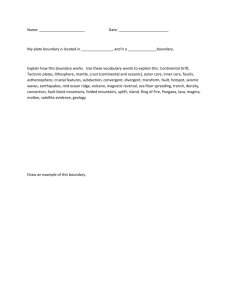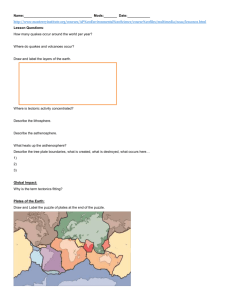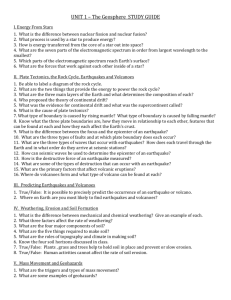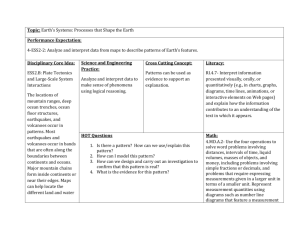Earthquake and Plate Boundaries – 3D Animations using ArcGIS 9
advertisement
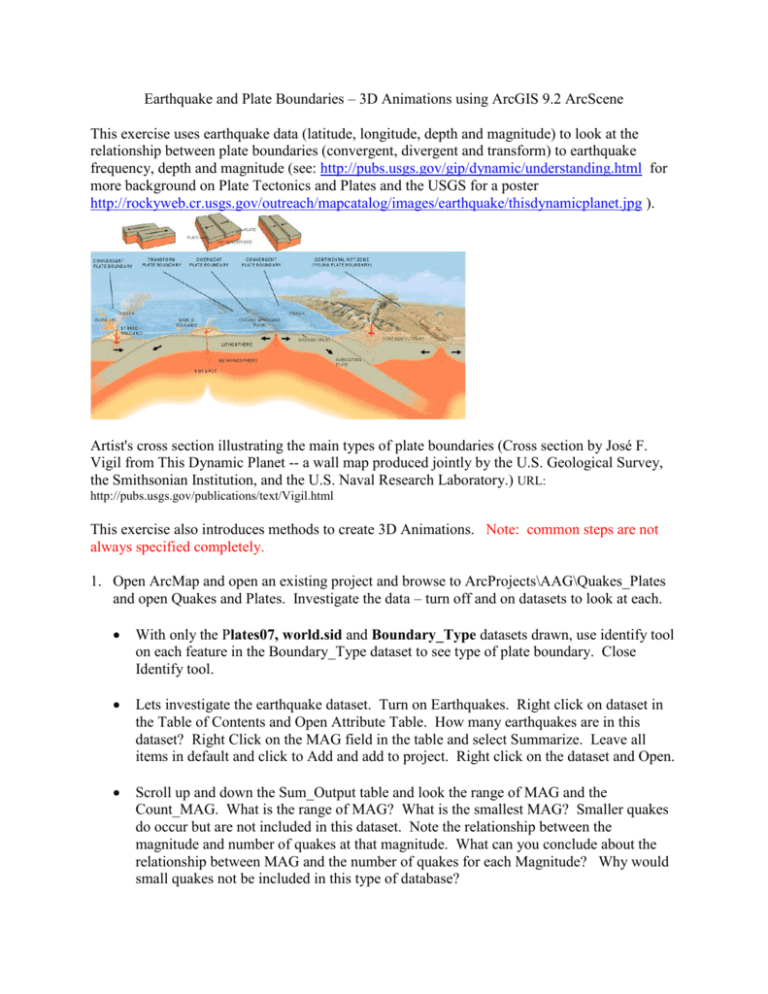
Earthquake and Plate Boundaries – 3D Animations using ArcGIS 9.2 ArcScene This exercise uses earthquake data (latitude, longitude, depth and magnitude) to look at the relationship between plate boundaries (convergent, divergent and transform) to earthquake frequency, depth and magnitude (see: http://pubs.usgs.gov/gip/dynamic/understanding.html for more background on Plate Tectonics and Plates and the USGS for a poster http://rockyweb.cr.usgs.gov/outreach/mapcatalog/images/earthquake/thisdynamicplanet.jpg ). Artist's cross section illustrating the main types of plate boundaries (Cross section by José F. Vigil from This Dynamic Planet -- a wall map produced jointly by the U.S. Geological Survey, the Smithsonian Institution, and the U.S. Naval Research Laboratory.) URL: http://pubs.usgs.gov/publications/text/Vigil.html This exercise also introduces methods to create 3D Animations. Note: common steps are not always specified completely. 1. Open ArcMap and open an existing project and browse to ArcProjects\AAG\Quakes_Plates and open Quakes and Plates. Investigate the data – turn off and on datasets to look at each. With only the Plates07, world.sid and Boundary_Type datasets drawn, use identify tool on each feature in the Boundary_Type dataset to see type of plate boundary. Close Identify tool. Lets investigate the earthquake dataset. Turn on Earthquakes. Right click on dataset in the Table of Contents and Open Attribute Table. How many earthquakes are in this dataset? Right Click on the MAG field in the table and select Summarize. Leave all items in default and click to Add and add to project. Right click on the dataset and Open. Scroll up and down the Sum_Output table and look the range of MAG and the Count_MAG. What is the range of MAG? What is the smallest MAG? Smaller quakes do occur but are not included in this dataset. Note the relationship between the magnitude and number of quakes at that magnitude. What can you conclude about the relationship between MAG and the number of quakes for each Magnitude? Why would small quakes not be included in this type of database? Close all Tables. 2. We are now going to symbolize these points using attribute values of depth (DEP) and symbolize them using a color ramp in order to compare depth of earthquake (Focus) and plate boundary type. Right Click on Earthquakes dataset and select Properties, then select Symbology tab and click on Quantities and Graduated Color. For “Fields” Value select DEP and pick a color ramp (Yellow to Red to Blue or “Distance”). Click on the Classify button and change the number of Classes to 10 (may have to change the Method to Natural Breaks to be able to change number of Classes). Note: you may get a Warning that not all data is being used, if you do, Click OK and then Click on the Sampling button and change the Data Sampling Maximum Sample Size to a number larger than the “Count” number you found in the SUM_Out table. In the Break Value table type in values: 5, 10, 25, 35, 45, 75, 100, 150, 200 and leaving the last number as it is. Click OK, and OK. Turn off world.sid, and draw Volcanoes and Continents. Click on the symbol for Volcanoes and change it to Red. Now investigate how the depth of earthquakes changes for each Boundary_Type by zooming in and out to each Boundary_Type point and using the legend you created for depth and the identify tool compare depth of earthquakes. Are deep earthquakes found along mid-ocean ridges? Why not? Does depth appear to increase when you look at earthquakes along a traverse across a convergent boundary? Use various Zoom In and Out tools to look at different regions and plate boundaries – turning off all data except volcanoes, Boundary_Type and plates. Turn off and on Earthquakes. Note that there appears to be a relationship between the location of volcanoes along Convergent Plate Boundaries and the plate boundary. Next we will look at this relationship in detail. Zoom in to the West Cost of South America and turn off Earthquakes. Click on Measure Tool and using the dropdown arrow on the Measure tool, select Miles as your unit (note this data is in decimal degrees). Measure the distance from the plate boundary to the line of volcanoes. What is the distance? Why do you think they all line up parallel to the plate boundary and are at the very similar distances from the plate boundary? We will investigate this relationship more closely using ArcScene in 3D. Close the Measure tool and zoom out to full extent. Create a Quake Depth Layer by Right Clicking on the symbolized by depth earthquakes and selecting Save as Layer File. Name it Quakes by Depth being sure that it is saved in the Lyrfile folder for your Project. Be sure that Extensions are checked on for Spatial and 3D Analyst and ToolBars are a available Tools > Extensions > check on Spatial and 3D View > Toolbars > check on Spatial and 3D 3. We will create a new dataset that shows the regions of the world with the highest density of larger magnitude earthquakes using Spatial Analyst Toolbar and Density tool. Note you can “try different value”s on the input for the Density tool, but we are going to use the ones below Spatial Analyst Toolbar > Density 1. 2. 3. 4. 5. 6. 7. 8. Input data = Earthquakes Population = Mag Density = Kernel Search Radius = 50 Area Units leave as default Out Put Size = 2 Browse to the Scratch_Temp folder and name the output Mag_Den Click Save and then OK This new dataset allows visualization of the distribution of large earthquakes and it illustrates that earthquakes are not evenly distributed around the world, but that there are areas where there is a higher density of large quakes. Right click on the dataset and select Properties. Pick the Symbology Tab and click on the Classify button. Note that the histogram of the data indicates a large number of values below 5. Change the number of classes to 9 and type in Break Values of: 0.5, 1, 2, 3, 5, 8, 10, 15, 25 click OK. You can create a Hillshade to better visualize the results by using the Spatial Analyst Toolbar and Surface Analysis Tool, Hillshade. Save as Hilsh_Quake in the Scratch_Temp folder. Right click on Hilsh_Quake, Properties, Display tab and set transparence to 60% (or experiment with various values), click OK. Create two Layers – one for the Mag_Den and Hilsh_Quake in the Lyrfile folder (for each layer, right click on dataset name and select Save As a Layer in the Lyrfile folder). Save your Project and close ArcMap. 4. Open ArcScene. Under File and Document Properties be sure that Data Source Options path is set to relative paths and fill in Title (Quakes In 3D). Save project using same name in Plates_Quakes folder. Use Add Data Button and add from the Shpfile folder add Plates07, continents, faults and volcanoes and click Add. Use Add button again and add from Lyrfile folder and add Quakes by Depth layer for earthquakes and Mag_Den ArcScene lets you visualize the data in 3D but you will have to set the base heights for some of your datasets. Right click on Earthquakes and select Properties then select Base Heights tab. In Offset use “calculator” and Select and then type using keypad on dialogue box: DEP*-.08 then Click OK, OK. Click on the symbol for plates07 and make Fill No Color and increase Outline Width to 4 and Color of outline to Solar Yellow. Click on the symbol for volcanoes and change Color to Red, in same dialogue click on Properties and Change Tpye to 3D Simple Marker Symbol and for Style pick Cone and click OK. Then Change Size to 2 and change Z to 2 and click Ok. Right click on the Mag_Dem datalayer, Properties and Base Heights tab and the Mag_Dem to obtainheights. Click on Symbology Tab and ceck box for User Hillshade Effect. Click OK Change the color of other datasets as needed. Use the 3D tools to change the orientation of the Scene and zoom in and out to various boundaries. Turn on and off layers to view the earthquake and plats and visualize the difference in depth and magnitude for each different type of boundary. Save ArcScene often Can you see differences and angles associated with Convergent boundaries such as along west coast of South American? Compare the location of the plate boundary, location of volcanoes and the offset of earthquake depths along South American and along the convergent boundaries in the Ring of Fire in Asia. Can this help identify subduction zones? What depth are most of the earthquakes along mid-ocean ridges? Turn on the Mag_Den dataset and tilt the scene to compare the numbers of quakes globally. Are there differences globally in density of quakes? Think too about the units used for this analysis – could this be a problem? 5. You can create a simple animation of this data set. Add Animation Tool bar if not already available (View > Toolbars > animation). Begin your animation by positioning the data in ArcScene as you would your animation to begin. Click on the “camera” on the Animation toolbar, and move (zoom in, zoom out or tilt the view) to at least 8 different locations clicking camera each time you have repositioned your Scene Click in Animation toolbar on Options and under Animation Controls set duration to 25 seconds Play animation (Arrow button): You can change duration, delete animation and redo, or change playback mode to Loop or Reverse the animation automatically. You can also save your animation file or create a video to share with others.

